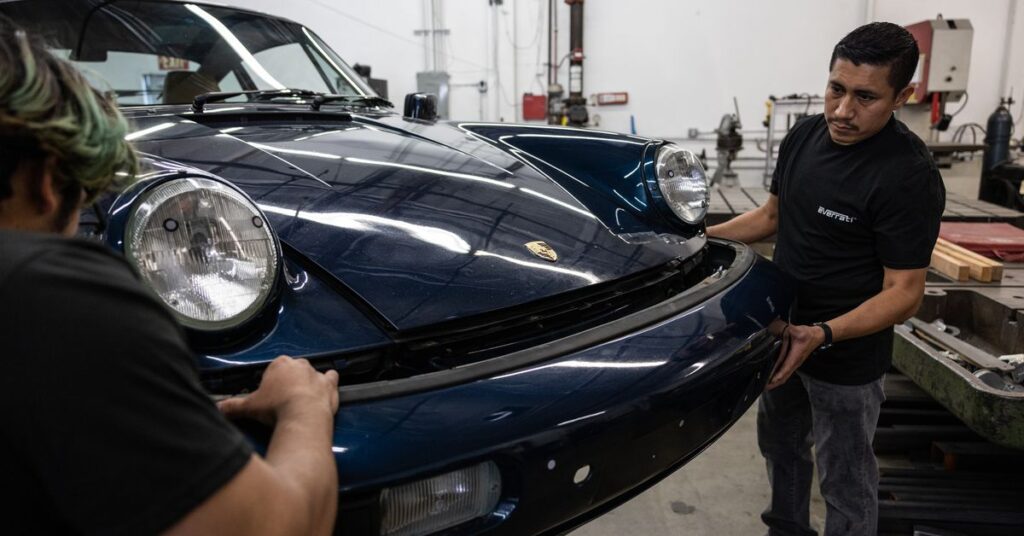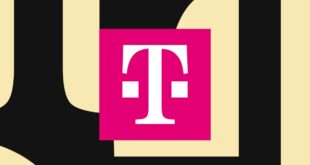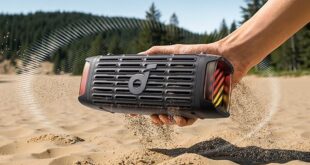
When we last spoke with Everrati CEO Justin Lunny, his UK-based restomod company that converts iconic cars to electric vehicles was expanding into the US market. Since then, the company set up headquarters in Calabasas, California, and in April, it partnered with Irvine-based manufacturer Aria Group to work on state-side electric conversions of Porsches and other prestige vehicles. Now Aria Group is helping build the first Everrati Porsche in California, and the owner of that car is a major investor: former Nest CEO Matt Rogers.
Rogers’ car is a Porsche 911 (type 964) wide body, similar to his father’s that he has fond memories of riding in as a kid. Since then, he promised himself that he’d get one, too, but only if it were electric. The once Apple engineer left Nest in 2018 and has since been focused on technologies to help fight climate change. Rogers heard about Everrati through a UK-based publication and contacted the company to inquire about its business and future — and, of course, about getting his Porsche converted.
That’s where Aria Group comes in: the low-volume manufacturer has worked on bespoke vehicles from Singer Vehicle Design, which makes custom Porsche 911s, and Radford Motors, which outfits luxury vehicles, and now it’s working on the first US-built Porsche 911 (964) wide body Everrati Signature Edition with the performance pack. It uses Everrati’s 700-volt EV powertrain that can go 0-62 mph in under four seconds and can travel up to 200 miles on one charge. Lunny says that demand for their electrified icons is surging globally, and California, with its abundance of sustainability-conscious young professionals, has more interested customers than anywhere. In just the past month, Everrati picked up four more orders of the Porsche 964, Lunny tells us.
This transcript is from an interview on June 23rd and has been lightly edited for clarity.
So, “Restomods.” I guess it’s a term because most shops are still modifying cars; therefore, it’s a modification.
Matt: That’s right.
And they’re restoring, so it’s a restoration. Do you think that’s not giving it enough justice?
Matt: Restoration implies, like, you’re going backwards in time and bringing out the best of what it was. And this [Everrati] is like, you’re bringing out the best of what it was and bringing it forward in the future. And I think that like the original Tesla Roadster, they didn’t really call it a restomod. But in today’s lingo, it totally would be.
Justin, I was interested in hearing what’s changed since we talked last? You’re expanding into the US market, you picked up a partner from gettacar…
Justin: Yeah, that’s right. Amit [Chandarana] joined. He’s very much looking at how we develop some of our commercial operations in North America. You’ll also have seen that we are partnering very closely with Aria. Aria [is] building Matt’s car as we speak, literally.
Matt: I got some fun photos the other day, actually.
Justin: It’s kind of exciting. Because, you know, I understand why things like restomod are used by definition because that is the word. But I suppose, as Matt rightly says, you know, hopefully, the vehicles are going to be better than new, clearly, because they are.
:no_upscale()/cdn.vox-cdn.com/uploads/chorus_asset/file/23901336/21E503EF_320B_48BB_A0F9_BE0E2229B245_1_105_c.jpeg)
Oh wow, and Aria is building that right now?
Matt: They sent me [that] like a couple days ago.
Justin: So where we are, I suppose as a business, we have a lot of interest now, from people who, I’ll be honest, either have had Singers or are on a waiting list for Singer … two of them said they’re going to cancel that because they don’t believe it’s going to be socially acceptable to take delivery of a million dollar combustion engine vehicle at that point.
Matt: I mean, I wouldn’t do it. If you’re gonna invest the time to build something so special, why do a gasoline-powered engine? Just doesn’t make any sense.
Is this something that a lot of the high-end vehicle manufacturers are seeing? Their general customers are coming back to them saying: “Hey, we don’t really want this kind of stuff anymore?”
Justin: Really good question. I think certainly the way, let’s be honest, there’s so many new products out there right now, new EVs and, dare I say, our gateway drug is a [Porsche] Taycan. People that have a Taycan, they kind of think, “Wow, this is an amazing performance EV that drives like a proper car,” … it’s no wonder Porsche is doing so well with them.
I remember that Everrati engineers and builds a plan for each model car. Is that still what you guys are doing? Is that how Aria Group is doing it right now — that they have a sort of blueprint of a vehicle, and they can repeat the process?
Justin: Completely. I think the big difference with what we do is that our engineers have experience building brand new EVs, right from the Lotus Evija powertrain; Mike, our head of engineering, designed the powertrain for that … We go about it a very different way. So there are converters out there, and good luck to them. So you look at somebody like EV West or a variety of others where, generally speaking, they’re not necessarily doing a productionized thing. They’re doing one-offs… they’ve really started a really interesting industry. We’re coming from the other side, which is to truly re-engineer what a vehicle is, and the process we call it is “redefined.” It’s got to drive, hopefully, as closely as it could to the original. And that’s kind of our secret sauce, I suppose.
I got to drive in a Ford F-100 Eluminator, which is a converted 1978 vehicle, and they used their crate motor. Do you think that there’s a lot of room to grow in that side of the market, and are you a part of that?
Justin: We’re kind of part of it, but we’re different. So our ethos is very much around in the same way as you might treat a beautiful brownstone house in New York, you’re not going to tear it apart, you’re going to keep the bits that are classic and are important to the structure … What you’re gonna do is treat it like the work of art it is and try and update it sympathetically — so that it still looks, feels, and drives like an original but is now not emitting any CO2. Let’s be honest, the tailpipe emissions for them things are pretty horrible, you know, they’re pre-catalytic converter, I dread — really horrible — you know, stuff that you do not want around you, let alone your kids, right? It’s just not nice.
Matt, you’re here, you have this extensive design background, and you found out about Everrati. Can you tell me about how that came to be and why you invested in them?
Matt: Yeah. So it’s probably a few years back at this point, like I saw a piece on them in the UK press. And it’s one of those things, as both an environmentalist and clean tech entrepreneur and a Porsche enthusiast — there’s not a lot of intersections of those things. So, I reached out — and at this point, there’s no partnership with Aria — I spoke to Justin and Neil like, ‘oh, maybe we’ll build it in the UK, and we’ll ship it over.’ And, wait, like, there’s a lot of demand in the US — maybe we actually [should] build out some US operations … and yeah, I’m super excited about this, as a car enthusiast — I just can’t see the tailpipe emissions happening anymore. This is the way.
Everybody’s buying EVs in California. You see them everywhere. Do you own an EV right now?
Matt: Yes, I have a Lucid Air — actually, I was one of the first customers for Lucid too. We have an Audi E-Tron, and I used to have a Tesla Model X, but we got rid of that one and used to have a Taycan, which was amazing, but I only had so much garage space. I still have a vintage 911, which I think I’ll probably sell as well once the Everrati is ready.
I started driving an EV in 2016, and despite the really low range on a Nissan Leaf at the time…
Matt: That’s what I had, too! I bought a Nissan Leaf, thinking it was like a 2013 or 2014.
I had the 2013 as well!
Matt: I got like 70 miles of range. It was horrendous. But not ever having to go to a gas station was awesome.
Things are a lot different today.
Matt: Indeed. Technology and scale drive cost down, and even like incremental change, battery technology has gotten better, like 5 to 10 percent per year. But over like a 15-year period, that’s a lot of accumulation, the fact that you can get a car now that has 500 miles of electric range is insane.
Which car do you have in the shop right now getting converted?
Matt: It’s a 964, so it’s like a 1991 911.
So you’ll have two of these vintage Porsches getting converted to EV!
Matt: I’m gonna get rid of the 993, my ’98. I don’t need to have two vintage 911s. I think electric only is the way to go. So my daughter — I have a four-year-old daughter — she sits in the back, and she asked me, “Why is it so loud?” It’s like an era of time.
Justin: Yeah, It’s so funny, my seven-year-old son, we rode in my Taycan on the way to school, and we were following a Panamera Turbo … it’s got fumes coming out of the rear — it’s probably only water, let’s be honest — but he was really upset that this car in front of us was potentially polluting our air. And it’s really interesting how the younger generation are just on board with all of this so quickly — without us trying …
With the rising cost of batteries, how has that affected your market?
Justin: It doesn’t affect us directly because we’re paying such high prices for batteries [already]. Performance is improving on a price per kilowatt hour, actually. And over time, it will definitely go down. So — it’s not really affecting us right now.
What type of cells are you using right now?
Justin: [via email: we use active cooled VDA batteries in the Porsche] In our Land Rover series, we use envision cells — from the Nissan group, effectively. There was some press around Porsche that they don’t want to over-weigh a car — now the Taycan is not light — but a sports car is a sports car, and it should feel alive, essentially.
Matt: 150-200 miles is kind of the sweet spot.
:no_upscale()/cdn.vox-cdn.com/uploads/chorus_asset/file/23901381/Everrati_Advanced_Technologies_2_.png)
:no_upscale()/cdn.vox-cdn.com/uploads/chorus_asset/file/23901382/Everrati_Advanced_Technologies.png)
Justin: We’ve just done some testing on our GT40, and — we’ve got it charging up to 150 kilowatts. If you think about that in a car that is done by a restomod company [comparatively], that’s a 700-volt architecture … it’s not quite Taycan, in terms of its ability to do multiple performance runs, but it’s not far off. If you’ve got fast charging on the track, you could be charging and back out on the track in 20 minutes, which is actually pretty good, right?
Have the standardizations in the US been affecting you?
Justin: Yeah, we use CCS2 in Europe, and the intention is to use CCS1 in the United States. And in Europe anyway, [Tesla Superchargers], the ones that are opening up to non-Tesla, you can use your CCS port as well. Our hope is that continues to grow in popularity, but we can utilize any potential core.
Matt: Yeah, this is really just a Tesla problem. The rest of the industry is just about one standard. Like the Apple lock-in… I think the tides are turning on that — between what the non-profit environmental community is pushing on and that the industry groups are pushing on, those times are changing.
Justin: Yeah, you’ve seen in the mobile phone space, where in Europe they’re now effectively stopping anybody using different charge connectors, they have to use USB-C. I think that’s good. Unless there’s huge technology benefits for doing something else, then you’re just wasting resources.
Matt: Maybe 15 years ago there was, but today it’s just creating bifurcation in the market just to have it.
Justin: You look at Gen Z, look at millennials, [they] wouldn’t even dream probably of having a non-EV, you know, that’s getting really exciting for us. Just a little tiny story: My wife, I lent her my Taycan, and she did an all-female car tour … raising money for female charities in South Africa for children. I really missed my Taycan for that week it was away, and I had to drive … her G wagon. Also, it cost me nearly 500 pounds in three days for a few long trips. The argument has been lost — I think — in terms of sticking with the combustion engine, certainly.
What about one of your conversion Land Rovers?
Justin: I went to a UK government site who were looking at electrification, and they actually had our Land Rover on site, hence I couldn’t drive it. I turn up with my G wagon, and you can imagine what kind of excuses I had to make. So I showed them a picture of my wife in Barcelona with my EV, so it wasn’t all bad. It just isn’t for me, I genuinely was a true petrol head, but I’m just not there anymore.
Have you had any more US orders?
Matt: I think the backlog is pretty significant at this point
Justin: It’s six Porsche orders in the last five or six weeks. Which is fantastic. And we’re getting Land Rover orders as well, which is a bit different of a market. Our plan was to launch the business in March 2020, and as we all know, that wasn’t the best time for any business, quite frankly. But we persevered … I think peoples’ view on sustainability, on clean air, during the pandemic really kind of accelerated.
Do you see Everrati evolving to convert pretty much any car?
Justin: What we’re more focused on is the powertrains themselves … We are in conversation with a company right now that’s likely to want us to build tens, if not hundreds, of Landrovers over the next three years. But we will do the powertrain. We won’t do the whole car. So that’s kind of where the volumes come in for us. We have this concept of ‘Everrati inside’ kind of thing. It’s like the Intel inside … It’s great for us because we’re getting involved in more vehicles. Also, I guess from an economies of scale perspective, we’re buying more batteries, more inverters… we can start to hopefully reduce our own material costs over time as well.
Matt: It’s interesting to hear you say Justin because I think about the Tesla journey and the forks in the road along that journey, and they started kind of in a similar place. They did that Lotus Elise conversion, then they were licensing the powertrain, and then they did a deal with Toyota — and they had that RAV4 EV. Then they kind of went the full Apple way. I think there’s an important market segment for ‘the EV inside.’ It’s a whole new market today that doesn’t really exist.
We’re almost out of time here, but just a quick question for Matt — do you still have the Nest fire truck from 2014?
Matt: Funny you should say that, actually! I got a call from a friend at Google asking if I wanted it. It’s literally sitting in a parking lot in Mountain View on the Google campus. It’s just sitting there.
Can you guys do anything with it?
Matt: An electric fire truck… That actually would be a fun one!
Justin: That’d be a fun one!
Matt: It’s funny you should say that. It’s just sitting there.
As long as the horn still works, we’ll get Nilay in, and he’ll get to honk it as many times as he’d like.
Matt: Oh my gosh, yea, indeed!
Thanks so much for talking with us. I would love to talk to you guys again soon and see where this is all going.
Matt: Totally!
Thank you so much, guys!
Matt: Indeed!
Justin: Have a great day, guys. Take care!
Source link
 Latest World Breaking News Online News Portal
Latest World Breaking News Online News Portal






